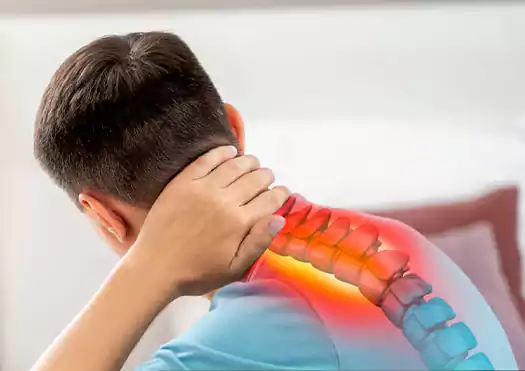Neck pain, or cervicalgia (మెడ నొప్పి - Meda noppi), is a common ailment characterized by discomfort in the cervical spine, which is the portion of the spinal column located in the neck. The intensity and nature of neck pain can vary significantly, ranging from a mild, dull ache to severe, sharp, or shooting pain. It can be acute (lasting for a few days or weeks) or chronic (persisting for more than three months). Neck pain can be localized to the neck area or radiate to the shoulders, upper back, arms, and even cause headaches.
The causes of neck pain are diverse and can include mechanical issues, injuries, and underlying medical conditions. Common mechanical causes include muscle strains and sprains due to poor posture (such as prolonged computer use or looking down at mobile devices - often termed "tech neck"), sleeping in an awkward position, sudden jerky movements, and stress-induced muscle tension. Degenerative changes in the cervical spine, such as cervical spondylosis (arthritis of the neck) and degenerative disc disease, are also frequent culprits, as they can narrow the spinal canal or the openings where nerves exit (neural foramina), leading to nerve compression.
Injuries like whiplash from car accidents or sports-related trauma can cause significant neck pain due to the sudden stretching and tearing of muscles and ligaments. Less common but more serious causes can include herniated cervical discs that press on nerves (as described in item 11), spinal stenosis (narrowing of the spinal canal in the neck), infections, tumors, and certain systemic inflammatory conditions.
Symptoms associated with neck pain can extend beyond just discomfort in the neck itself. These may include stiffness and limited range of motion, difficulty turning the head, muscle spasms, headaches (often originating at the base of the skull), and pain that radiates down the shoulders and arms. When nerve compression is involved (as highlighted in item 11), individuals may experience numbness, tingling, weakness, and a "pins and needles" sensation in their arms and hands. The specific pattern and distribution of these neurological symptoms can help identify which nerve root is affected.
Diagnosis of neck pain typically involves a thorough medical history, a physical examination to assess posture, range of motion, reflexes, muscle strength, and sensation, and palpation of the neck muscles. Imaging studies such as X-rays can help visualize the bony structures of the cervical spine and identify any fractures, arthritis, or misalignments. MRI scans are often used to provide detailed images of the soft tissues, including the intervertebral discs, nerves, and spinal cord, and are particularly useful in identifying disc herniations or spinal stenosis. In some cases, nerve conduction studies and electromyography (EMG) may be performed to evaluate nerve function.
Treatment for neck pain is often multimodal and depends on the underlying cause and severity of the symptoms. Conservative management is usually the first approach and may include rest, activity modification, pain relievers (over-the-counter and prescription), nonsteroidal anti-inflammatory drugs (NSAIDs), muscle relaxants, and the use of a cervical collar for short-term support. Physical therapy plays a crucial role in strengthening neck and upper back muscles, improving posture and flexibility, and teaching proper body mechanics. Other conservative treatments may include heat or cold therapy, massage therapy, chiropractic manipulation, and acupuncture.
In cases of persistent or severe neck pain that does not respond to conservative measures, or when there are signs of significant nerve compression leading to progressive neurological deficits (as described in item 11), more invasive treatments such as cervical epidural steroid injections to reduce inflammation around the nerve roots or surgical intervention may be considered. Surgical options can include anterior cervical discectomy and fusion (ACDF) to remove a damaged disc and stabilize the spine, or cervical laminectomy or laminoplasty to create more space for the spinal cord and nerves. Rehabilitation following more invasive treatments is essential for regaining strength, mobility, and function. Patient education on ergonomics, posture, and self-care strategies is also vital for long-term management and prevention of recurrent neck pain.
